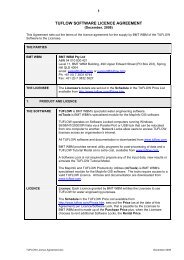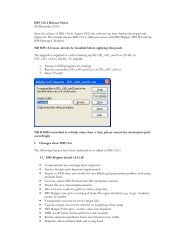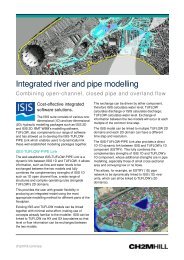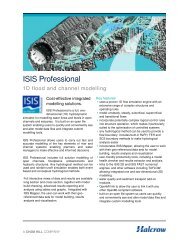December 2008 - Halcrow
December 2008 - Halcrow
December 2008 - Halcrow
You also want an ePaper? Increase the reach of your titles
YUMPU automatically turns print PDFs into web optimized ePapers that Google loves.
in 1979 <strong>Halcrow</strong>’s work in the Middle East represented around 95 per cent of annual revenue, and employee numbers<br />
swelled to 2,700. The early 1980s saw engineering investment in the region fall dramatically, and <strong>Halcrow</strong> was forced to<br />
significantly reduce its workforce.<br />
By 1990, the UK accounted for 79 per cent of the firm’s earnings and employee numbers started to<br />
rise again. When the British government embarked on a major programme of road building,<br />
<strong>Halcrow</strong> was awarded years of motorway building work. The business was also<br />
involved in the Queen Elizabeth II bridge building project at Dartford and the<br />
major second Severn Bridge.<br />
In 1979, <strong>Halcrow</strong>’s work in the<br />
Middle East represented<br />
95 per cent of annual revenue<br />
Among its high-profile global successes, <strong>Halcrow</strong> helped construct<br />
one of the 20 th century’s greatest engineering feats – the Channel<br />
Tunnel. Its key role in managing the scheme involved fielding<br />
more than 50 engineers at the tunnelling and maritime sites<br />
in Dover.<br />
In the last five years the company has successfully<br />
expanded into the North American market, with<br />
one tenth of its 8,000-strong global workforce<br />
now based there. An achievement of which its<br />
visionary founder would be justly proud.<br />
World War II<br />
Britain’s finest hour was also Sir William’s<br />
A member of the War Cabinet’s engineering advisory<br />
committee, Sir William was also consultant to the secretary of<br />
state for war on ports and adviser to Bomber Command.<br />
To help shield London’s residents from the forthcoming horrors of<br />
the Blitz, eight new deep-level air raid shelters were built under stations<br />
such as Goodge Street and Camden Town. Goodge Street, designed by<br />
Sir William, became the most important of the shelters – it was from there that<br />
US president Eisenhower directed the D-Day Normandy landings.<br />
His tunnelling knowledge helped London Underground construct floodgates at<br />
strategic stations to protect the city from flooding. He also became a hero of the arts when<br />
he identified the Manod slate quarry in north Wales as a safe haven from war-torn London<br />
for the National Gallery’s treasures. And Sir William’s knowledge of dam construction was<br />
used by Barnes Wallis to help perfect the bomb used by the Dam Busters in 1943.<br />
Elsewhere, the company was involved in designing the reinforced concrete caissons that made<br />
up Mulberry Harbour – a vast prefabricated port built in Britain. This was towed across the<br />
channel after D-Day to create two great harbours – Arromanches<br />
and St Laurent. Their construction allowed the Allied armies<br />
to be supplied by sea and ultimately liberated France from<br />
the Nazis. The towing operation moved King George VI to<br />
remark that this was “the greatest combined operation the<br />
world has ever seen, perhaps the greatest it will ever see”.<br />
In 1946, Sir William became president of<br />
the Institution of Civil Engineers, a fitting<br />
recognition for his wartime contribution.<br />
Sir William’s<br />
knowledge<br />
of dam<br />
construction<br />
was used to<br />
help perfect<br />
the bouncing<br />
bomb used<br />
by the<br />
Dam Busters

















